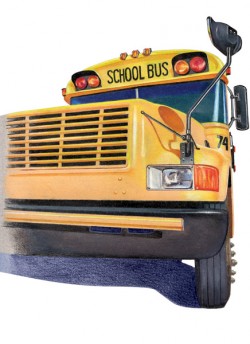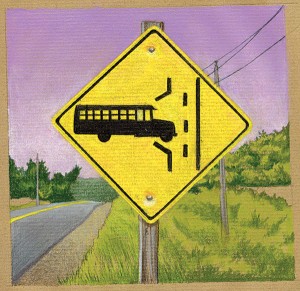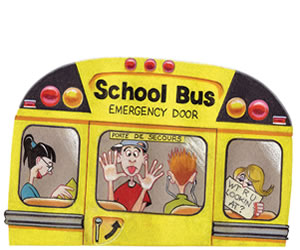On the Buses
The school bus industry is going global, but the safety of our children still depends on the steel nerves and good sense of the local drivers.
John Russell left home at sixteen. He didn’t have family problems, he wasn’t looking for work, he simply wanted to graduate from high school.
John’s home in Laurel was almost ten miles from the high school in Orangeville, and in 1942 there was no school bus service available to rural students in the hills. By that time, some one-room schools were providing instruction through grades 9 and 10, but to complete their education John and a dozen or so of his country cousins had to board in town during the school week.
More than sixty years later, school buses on our rural roads are as ubiquitous as ants at a picnic. Some 17,000 of them shuttle 800,000 Ontario students daily between home and school.
How did that happen? The big change in student transportation began in earnest after the Second World War. The Depression had inspired a taste for the relative financial security offered by “the professions” and had accelerated migration from farms to cities where many jobs required more formal qualifications. But rigorous curriculum and oppressive government exams continued to discourage the majority from moving much beyond elementary school. John Russell’s grade 13 class, for example, had only ten students.
 However, as returning servicemen swelled the demand, politicians and educational authorities began to respond. Vocational and technical courses were introduced to democratize the curriculum, and school districts were amalgamated to centralize administration. Even so, high school graduation remained a remote possibility for the many rural students who still had to find a way to distant classrooms.
However, as returning servicemen swelled the demand, politicians and educational authorities began to respond. Vocational and technical courses were introduced to democratize the curriculum, and school districts were amalgamated to centralize administration. Even so, high school graduation remained a remote possibility for the many rural students who still had to find a way to distant classrooms.
The problem was considered so severe at the time that one study declared: “The discrepancy between urban and rural secondary school attendance presents one of the most pressing problems which the country as a whole is facing.”
As is often the case, private enterprise rose to fill the gap. In his History of Education in Dufferin County, Ernest Dodds tells of a Mr. Brewer who bought a bus in 1946 and established a route that snaked the lines and side roads north of Highway 9 from Mono Mills to Orangeville. A year later Don Berdick established a run. The next year, “Mac Maude, a resident of Orangeville who had a taxi service to Guelph saw a future business in school buses. He purchased both the Berdick and Brewer buses, and continued for a number of years transporting children.”
But it was Angus Coles, and later his son Ron, who really got things going. Angus had a threshing and sawing business on Hockley Road, north of Orangeville. He also had five children. In 1940, Vern, the oldest, wanted to continue beyond the grade 10 limit of his country school. So, like John Russell, he had to find room and board in town.
At the end of that first school year Angus calculated what he would save if, instead of paying Mrs. Wansborough twelve dollars a week to put up his son, he gave Vern a 25-cent gallon of gas each day to drive back and forth. Angus no doubt also took into account what it would cost him if his other four offspring also wished to continue their education.
Angus’s middle son, Ron, remembers, “It wasn’t long till other kids along the Hockley Road wanted a ride. I’m pretty sure they paid my dad $1.25 a week. The car was full in no time flat.” In 1943, his sister Grace became a passenger, and she became the driver when Vern went off to university in the fall of 1944.
Angus Coles bought his first commercial vehicle in 1948 – a sixteen-seat van. His untimely death in 1965 left his widow with a fleet of three buses. Ron bought the business from his mother and by the time he sold to Charterways in 1988 the company ran eighty-seven buses. Meanwhile the Davisons, Langdons, Dennys and several other local operators had joined the business of transporting children to and from schools.
Soon enough the school bus business was booming. And today, like so many enterprises, the business has gone global. The few remaining family-owned operations are giving way to subsidiaries of multinational conglomerates, such as Student Transportation of Canada, which has a U.S. parent.
On the sides of many of the other coaches picking up and dropping off your kids, you will also see the names First Student Canada or Stock Transportation, both are branches of public companies with head offices in the UK. If you have ever ridden a train, a plane or a bus in Britain you have probably been a customer of one of their parent companies, First Group or National Express Corporation respectively.
 The three companies now transport all the students in Caledon (though the Peel board still contracts with several independent operators in Brampton and Mississauga) and about half the students in Wellington and Dufferin, where about ten local companies account for the rest.
The three companies now transport all the students in Caledon (though the Peel board still contracts with several independent operators in Brampton and Mississauga) and about half the students in Wellington and Dufferin, where about ten local companies account for the rest.
(When I called the local office of First Student Canada to discuss school busing in our area, the local employees told me that, in compliance with company policy, they were required to decline communication with the media. Apparently, that too, is controlled offshore.)
Just as the industry is changing, so is the government policy directing it. Ontario’s Ministry of Education established the auspiciously titled Efficiency and Effectiveness Review Committee in part to assess transportation procedures.
One change has been implemented already. All five boards in Wellington and Dufferin (Upper Grand, Wellington Catholic, French Catholic, French Public and Dufferin/Peel Catholic) are co-ordinating routes to reduce duplication of services.
Another, perhaps less welcome change, concerns the awarding of contracts. In the past all the operators met with board representatives once a year to negotiate a contract that aimed at striking a fair balance between the operators’ costs and the boards’ budgets. As of next year, the ministry has recommended that boards request competitive proposals from the operators. That has some independent operators and school transportation managers worried about the future. Their concern is that the multinationals can afford to lowball long enough to force out the independents, then set their own agenda.
Operators are also concerned about their rising costs at the diesel pumps. School buses are gluttonous creatures, consuming about a litre of fuel every three kilometres. Greg Seguin, manager of Wellington-Dufferin Student Transportation Services, says that in his jurisdiction, buses logged over five million kilometres last school year. He notes that “recent escalations in fuel prices added almost a million dollars to our customary $5 million bill.”
But all the complexities of the global oil crisis, international finance and political policy-making pale before the single overriding concern of the school bus industry: the safety of what bus driver Shirley Smith calls “the most precious cargo in the world.”
Any casualty involving a school child is a casualty too many. Still, the industry has a record of relative safety. According to Transport Canada, “The occupants of school buses are sixteen times less likely to be injured in road collisions than occupants of any other vehicle. Only three per cent of the one and a half million casualty-causing collisions involve school buses.”
Part of that is because the construction and equipment standards for school buses are controlled by more federal and provincial regulations than any other motorized vehicle on the road.
One of those regulations has to do with the ubiquitous “school bus yellow” or, as it is officially called, “Chrome Yellow” – a colour reserved exclusively for school buses. The colour has been around since 1939 and research shows it can grab attention faster than any other; even our lateral vision picks up “school bus yellow” 1.24 times faster than it does red. In addition, the black lettering stands out against it in dim light or fog.
Still, the ultimate responsibility for the safety of our children continues to depend as much as anything on the steel nerves and good sense of the individual drivers who chauffeur 10,000 or so students around Dufferin, Caledon and Erin every school day.
Drivers are trained by the bus companies, under the close scrutiny of the Ministry of Transportation – but success at the job may have just as much to do with the personalities of the drivers.
Tom Lockhurst has been driving school buses for thirty-seven years and still finds the work gratifying. “Nothing bothers me out there,” he says.
What about that boisterous bundle of energy he’s hauling? Doesn’t that ever distract him?
“You know what kids are like, they’re lively and the occasional ones go a bit too far. I just take them aside and tell them, ‘I’d sooner solve the problem here than go into the school and report you – because if you have to go in there, then that’s a black mark against you.’ They usually respond well.”
Okay, but what about nasty weather?
“This is where experience helps,” he says. “I honestly only remember one time being a bit nervous. It was after a mid-day flash-freeze. I believe it was 2006, I do know it was on January 17. By good grace we did get through it without mishap.”
Shirley and Doug Smith have been driving buses for twenty-three and thirty-six years respectively. Both currently drive for First Student Canada. Shirley laughs heartily as she declares: “Right off the bat I loved it. Being around the kids you feel like you’re doing something for them. I love the wee ones – I treat them like they are my own.”
The Smiths also remember that January day Tom Lockhurst referred to. Doug had just dropped off his last couple of charges near Orangeville. Conditions had turned nasty very quickly and unexpectedly, and the bus radio clattered with drivers expressing concern or calling for help.
“Buses were stuck everywhere,” Doug recalls. Amid the cacophony he caught Shirley’s distress call. Halfway up a Caledon hill she had started to slide backwards. She had managed to get the bus stopped, but she was on the edge of a deep ditch. Any attempt to move might cause her to slide in. Her bus was still three-quarters full with kids.
Calculating where she would be on her route, Doug guessed what hill she might be on. He set out immediately to help his wife and the children in her care. It took him over half an hour in the conditions, but he had guessed correctly. He parked at the bottom of the hill and grappled his way along the ditch to Shirley’s bus.
In the bus, the students were subdued and all was quiet. With great care the two adults unloaded the children and ushered them down to Doug’s bus. Meanwhile Shirley had called the roads department and very soon a truck arrived to scratch the ice and spread some sand, allowing her to climb out of her dilemma. Doug followed.
Once they made the top of the hill they each took half the youngsters in order to deliver them home as quickly as possible. It was 8 p.m. when Shirley dropped off the last one. What she remembers most about that day was the gratitude of the parents when their children were finally safe at home.
Experiences like those are a reminder that the decision to call a “snow day” (oh, sweet delight to children, untimely frustration to parents) is not a frivolous one. Last winter was particularly troublesome, with weather causing fourteen days of bus cancellations – more than double the seasonal average.
When there is a hint of hazardous conditions on the horizon, every one concerned becomes glued to the forecasts. At such times, Greg Seguin starts his day between 4:30 and 5 a.m.
“My jurisdiction is split into four geographic areas each of which might experience dissimilar weather conditions,” he explains. “If there is a suspicion of danger, the lead operator in each section begins by contacting their road superintendents for feedback on what conditions road crews have found in the early morning dark. The OPP might also be contacted for the possibility of road closures. The lead operators then recommend a course of action to me.
“As the manager of transportation, I make the final decision before calling the directors of education to inform them. “The decision to go or not to go must be made by 6:15 a.m. in order to get the news out to the media, to post it on the board website, and to activate the phone-tree networks.”
Blowing snow is not the only cause for alarm, he says. The temperature is also critical. “Below -25C diesel fuel gels, causing the bus to stall and die. If the thermometer plummets to -35C (including wind chill), the schools are closed.” He adds, “School closures might also be the call if weather and road conditions are severe enough to warrant it.”
Some parents do complain about the inconvenience – and last year’s high number of cancellations drew particularly vocal criticism. Administrators do acknowledge that the weather conditions at 5 a.m. may not continue throughout the day. “We are not insensitive to parents’ concerns,” says Bob Borden, chairperson of the Upper Grand District School Board, “but our ultimate responsibility is the safety of the children.” Hard to argue.
Today, almost 80 per cent of the students who enter grade 9 in Ontario go on to graduate. In the big educational picture, it’s sometimes easy to overlook the essential role that school buses and their drivers contribute to that achievement.
Incidentally, John Russell spent forty-six years as a dentist in Orangeville. And the late Vern Coles retired in 1985 as a vice-president of Ontario Hydro.
Related Stories

School Bus Confidential
Sep 15, 2008 | | Back IssuesA memoir by Jesse Rivers. Every day was marked by two hours and twenty minutes of terror that one of these untamed big kids might move forward, as they did on occasion, to terrorize the cowering young.






